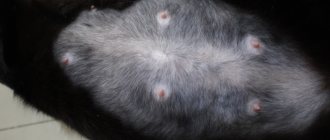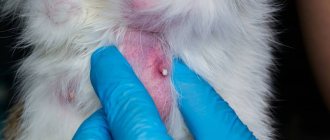7130Pavel
If a cat has a lump on the mammary gland, this may be a symptom of a serious disease - breast cancer. This disease, unfortunately, is not so rare in animals. Any female mammal can be affected: cats, dogs, rodents. It is more common in domestic pets than in wild animals.
A tumor on the mammary gland of a furry beauty is not necessarily cancerous. Benign formations also occur, but much less frequently. Also, the cause of the lump can be banal mastitis. Breast cancer and other pathologies manifested by a tumor on a cat’s chest are described in this article.
© shutterstock
Types of breast tumors
A mammary tumor in a cat can be of two types: malignant and benign.
I - malignant tumor . In 85 out of 100 diagnosed pathologies, there are malignant growths of glandular tissue, called adenocarcinoma or sarcoma. This is the most unfavorable type of disease, which, in the absence of timely treatment, inevitably leads to the death of the animal.
In this case, breast neoplasms have an irregular and tuberculate shape with many nodules of different sizes, which can open and bleed. The danger of a malignant tumor also lies in the development of foci of metastases and germination into neighboring tissues and organs. If left untreated, the lesions, having reached a certain size, begin to collapse, causing intoxication of the body and the rapid death of the cat.
II - benign tumor . The second type of mammary tumor is the formation of cysts or adenomas, which do not pose a threat to the life of the cat. A feature of this form of the disease is the likelihood of lesions growing to significant sizes and causing inconvenience to the animal, as well as the unaesthetic appearance of protruding irregularities when the cat moves.
Cysts and adenomas are not deadly diseases; they do not grow into neighboring organs and tissues and do not metastasize. Nevertheless, there are cases of adenoma degeneration into a malignant form.
Caring for your cat after surgery
After surgery to remove mammary cancer, the owner is required to follow certain recommendations for caring for the cat:
- It is important for the animal to create all the conditions for rapid recovery;
- Your doctor will help you create a diet;
- Seams and fabrics around need to be processed in a timely manner;
- Drug therapy after surgery allows you to form protection against infections in order to prevent complications;
- It is required to use protective bandages to prevent the animal from injuring itself;
- If you suspect a complication, you should immediately consult a doctor.
Symptoms of a tumor in cats
In a benign course of the disease, characteristic signs of a mammary gland tumor in cats are:
- Dense, nodular growths of a round shape, not fused to the skin;
- growth of glandular tissue to large sizes, with a high risk of injury (blood or exudate may ooze from the wound);
- The pet’s condition is unchanged, however, due to discomfort, there is a high probability of physical inactivity and weight gain.
Hormone-dependent adenocarcinoma (malignant tumor), as the most common mammary tumor in cats, has the following symptoms:
- Fixed nodules over the entire surface of the breast and nearby lymph nodes;
- painful sensations (expressed upon palpation of foci of inflammation);
- increased temperature and fever;
- decreased appetite, apathetic state;
- cats lick painful lumps, resulting in bleeding and purulent-necrotic wounds;
- emaciation.
Establishing diagnosis
What to do if a cat is suspected of having a mammary tumor - only a veterinarian knows (it is advisable to visit an oncologist). The sooner a cat is shown to a specialist, the fewer complications will arise with its health and the greater the chance of a successful outcome of the disease.
When examined in a veterinary clinic, a cat undergoes a number of diagnostic procedures:
- Examination with palpation and collection of anamnesis (medical history).
- Taking blood for laboratory tests of the animal’s general condition.
- Biopsy of pathological material (a piece of the neoplasm is examined under a microscope and allows us to determine the type of pathology with 100% certainty).
- Ultrasound or X-ray examinations (prescribed to identify the stage of development of the disease and determine the location of metastases).
Having received the results of the examination, it will not be difficult for the veterinarian to make an accurate diagnosis and prescribe appropriate treatment, taking into account the age and other characteristics of the cat.
An important point in diagnosing a neoplasm is differentiation from ailments with similar symptoms (mastitis, multiple insect bites), the treatment of which is expected to be completely different.
Treatment of breast tumor
Malignant tumor . The main method of treatment for all types of breast tumors is surgery to excise the overgrown gland tissue. If a malignant tumor is detected, then nearby lymph nodes are additionally removed, since they are most likely also affected. After the operation, the wound area is significant and has a large number of stitches.
If the cat has not been sterilized before, then in parallel with the operation, doctors advise removing the ovaries and uterus, this will lower the level of estrogen in the animal’s body and protect against further complications.
In the postoperative period (if the malignancy of the removed tumor is confirmed), a course of chemotherapy is prescribed, which is necessary to destroy the remnants of pathological cells. Therapy consists of drip administration of antitumor drugs at intervals of 3 weeks. The medications are easily tolerated by cats and do not cause thinning of the coat.
Benign tumor . Breast adenoma is also removed to exclude the possibility of cell degeneration.
If, due to the reasons identified during the examination of the animal, the operation becomes impossible, then conservative treatment is prescribed, the purpose of which is to stop the growth of the tumor with the prevention of injuries, as well as to increase the animal’s defenses. Special antitumor and antibacterial agents are used.
When a cat's mammary tumor ruptures, this indicates that the disease has become incurable. The owner's follow-up should focus on improving the animal's quality of life, pain management, and preventing bacterial infection. Do not forget that the exposed mammary tumor should be treated with antiseptic solutions and covered with a blanket so that the cat does not have the opportunity to lick it.
What is the problem and how does it manifest itself?
Symptoms of mastitis
When a cat has enlarged one nipple or both mammary glands, an inflammatory reaction may manifest itself in a similar way. The disease is more often observed in females during feeding of kittens, during which milk stagnation occurs. The occurrence of a lump near the breast is influenced by staphylococcal infection or E. coli activity. Pathogenic microorganisms enter the cat's body through the milk ducts or through the bloodstream. Mastitis can be recognized by the following signs:
- swelling of the mammary glands;
- heat;
- redness of the skin on the abdomen;
- compactions and small bumps;
- bloody or purulent impurities in the milk of a nursing cat;
- deteriorated general condition.
Veterinarians warn owners that if mastitis in the Sphynx and cats of other breeds is not treated in a timely manner, there is a high probability of degeneration of the mammary glands and the appearance of a tumor, including a malignant one.
Manifestation of pregnancy
This phenomenon is typical for females expecting offspring.
If a cat's mammary glands are swollen, this is the first signal of kitten conception. This sign is already observed after a month, especially in young individuals who become pregnant for the first time. After another 2-3 weeks, the owners note that the female not only has enlarged breasts, but also begins to produce milk. Closer to childbirth, the mammary glands become 2 times larger. If the increase is much greater, then you should see a veterinarian to rule out pathology.
False pregnancy: how to recognize?
This condition is not uncommon, and owners observe that the cat’s mammary glands are swollen and the appetite has increased, which is why they mistakenly believe that the animal has become pregnant. A similar violation is observed in a female who took a castrated cat for mating. The occurrence of false pregnancy and swelling of the mammary glands is influenced by pathology of the reproductive system or hormonal imbalance. To confirm successful conception, you need to contact a veterinarian who will prescribe an ultrasound diagnosis, but not earlier than a month after mating.
What is mastopathy?
Sometimes early sterilization of animals leads to this disease.
If the nipples turn blue and the mammary glands are swollen, this may indicate such a disease. Feline pathology is rare and most likely occurs after sterilization of an individual less than a year old. Mastopathy is a serious disease of the mammary glands, which often develops into oncology. With pathology, the female’s nipples look bad, and the skin near them is red and swollen. A lump appears in the chest area, and the cat exhibits other symptoms of mastopathy:
- bloody discharge from the nipples;
- seals;
- pain on palpation of the mammary glands.
How to recognize tumors?
Benign neoplasms: are they dangerous?
When a kitten or an adult has a blue area near the nipples, while it is dry and hard, this may be a signal of a tumor process. Often, cat owners observe that a benign tumor has formed after an injury or hormonal imbalance. Other factors also influence the development of the problem:
Pathology occurs more often in overweight animals.
- genetic predisposition;
- obesity;
- use of hormonal contraception;
- lack of sterilization.
A benign tumor is characterized not only by swelling of the mammary glands, but also by other signs:
- compaction that can be felt by palpation;
- enlarged lymph nodes;
- nipple discharge;
- changed behavior.
If you do not identify a benign tumor in a cat early on and do not remove it, then there is a high risk of its degeneration and the development of cancer.
Oncological process
The life of an animal is at risk if it is diagnosed with malignant tumors.
The Sphynx and other pet breeds often suffer from cancerous tumors, the development of which is influenced by various negative factors. When advanced, the neoplasm metastasizes to nearby and distant internal organs and lymph nodes. This deviation of the mammary glands poses the greatest danger to the health and life of the pet. At the initial stages, it is possible to recognize oncology in cats based on the following clinical picture:
- white or red spots on the nipples;
- swelling of the mammary glands;
- large lymph nodes;
- compaction when palpating the cat’s breasts;
- lethargy and causeless laziness.
In later stages, not only the lymph node in the mammary glands is enlarged, but also cancer cells spread to nearby tissues and organs. Often in oncology, metastases are recorded in the lungs, liver or brain. If the cancer process spreads, there is no chance to save the cat and veterinarians recommend euthanizing the animal to alleviate its suffering.
Preventive measures
To prevent neoplasms and early diagnosis of diseases, you should:
- Sterilize your cat before her first heat;
- do not use hormonal drugs without the advice of a doctor;
- see a veterinarian annually;
- monitor the cat’s weight, do not overfeed;
- provide active exercise in the fresh air.
A cat can lead a full life even with a diagnosis of a tumor and live long enough if the owners treat it in a timely manner.
Please rate the article. We tried our best:)
Prevention
You can prevent the occurrence of mastitis by following simple preventive measures.
- Hygiene. When a cat feeds her kittens, the skin around her nipples can become damaged, which can lead to bacteria entering the body. It is necessary to keep the room clean and treat pacifiers if scratches or cracks are found on them.
- Feeding. It is necessary to calculate and think through the cat’s diet, since consuming food that improves lactation can lead to the production of more milk than necessary and cause stagnation.
- Timely deworming and flea and tick treatment. Parasites can provoke allergies and cause itching, which will lead to scratching and damage to the skin.
- Monitoring the feeding of kittens. It is important to ensure that kittens eat from all nipples in turn, this will minimize the risk of stagnation in one of them.
In addition, you need to protect your cat from cold and drafts and monitor for possible postpartum complications.










